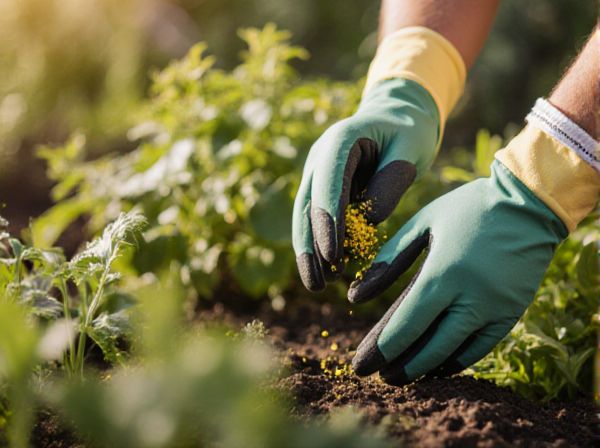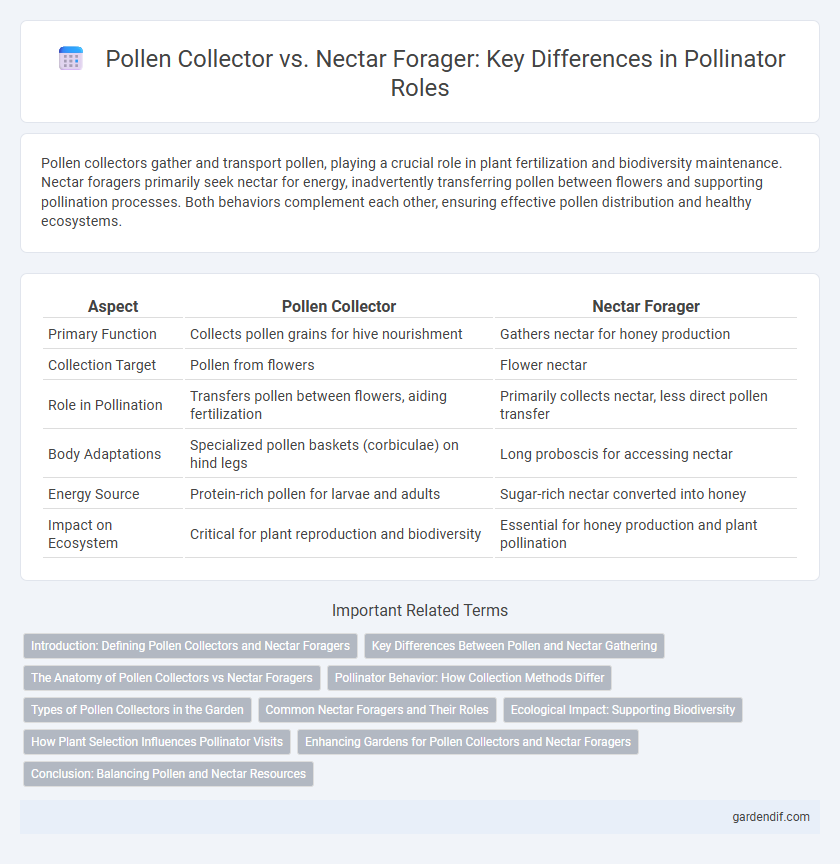
Pollen Collector vs Nectar Forager Illustration
Pollen collectors gather and transport pollen, playing a crucial role in plant fertilization and biodiversity maintenance. Nectar foragers primarily seek nectar for energy, inadvertently transferring pollen between flowers and supporting pollination processes. Both behaviors complement each other, ensuring effective pollen distribution and healthy ecosystems.
Table of Comparison
| Aspect | Pollen Collector | Nectar Forager |
|---|---|---|
| Primary Function | Collects pollen grains for hive nourishment | Gathers nectar for honey production |
| Collection Target | Pollen from flowers | Flower nectar |
| Role in Pollination | Transfers pollen between flowers, aiding fertilization | Primarily collects nectar, less direct pollen transfer |
| Body Adaptations | Specialized pollen baskets (corbiculae) on hind legs | Long proboscis for accessing nectar |
| Energy Source | Protein-rich pollen for larvae and adults | Sugar-rich nectar converted into honey |
| Impact on Ecosystem | Critical for plant reproduction and biodiversity | Essential for honey production and plant pollination |
Introduction: Defining Pollen Collectors and Nectar Foragers
Pollen collectors are pollinators specifically adapted to gather pollen, a protein-rich resource essential for their nourishment and reproduction, often equipped with specialized structures like pollen baskets or scopae to transport it effectively. Nectar foragers target the sugary nectar in flowers, focusing on energy intake while inadvertently facilitating cross-pollination as they move from bloom to bloom. Understanding these distinct roles highlights the complementary behaviors vital to ecosystem pollination dynamics and plant reproduction success.
Key Differences Between Pollen and Nectar Gathering
Pollen collectors primarily gather pollen grains, which are rich in proteins and essential nutrients for bee larvae development, using specialized body structures like pollen baskets on their legs. Nectar foragers focus on collecting nectar, a sugary liquid that serves as an energy source, typically stored in the bee's crop before being converted into honey. These key differences highlight distinct foraging behaviors and roles in colony nutrition, influencing the efficiency and specialization of pollinators in ecosystems.
The Anatomy of Pollen Collectors vs Nectar Foragers
Pollen collectors possess specialized branched hairs called scopal or corbicular structures on their legs or abdomen that efficiently trap and transport pollen grains, enabling effective pollination. In contrast, nectar foragers typically have longer, slender proboscises adapted for reaching deep floral nectar, prioritizing liquid collection without extensive pollen adhesion. The distinct anatomical adaptations reflect their unique roles in pollination ecology: pollen collectors emphasize pollen accumulation, while nectar foragers focus on nectar retrieval.
Pollinator Behavior: How Collection Methods Differ
Pollen collectors actively gather pollen grains to provision their nests, using specialized body structures like scopae or corbiculae to transport pollen. Nectar foragers primarily seek floral nectar as an energy source, visiting flowers more broadly but transferring less pollen per visit compared to pollen collectors. These distinct collection methods influence pollinator efficiency, with pollen collectors often contributing more directly to plant fertilization through targeted pollen transfer.
Types of Pollen Collectors in the Garden
Pollen collectors in the garden primarily include bees such as honeybees, bumblebees, and solitary bees, each specialized in gathering pollen to feed their colonies. These insects possess adaptations like pollen baskets (corbiculae) on their hind legs to efficiently transport large quantities of pollen. Effective pollen collection by these species enhances plant pollination, ensuring garden biodiversity and robust fruit production.
Common Nectar Foragers and Their Roles
Common nectar foragers include bees, butterflies, hummingbirds, and moths, each playing vital roles in pollination by transferring pollen while feeding on nectar. Bees are the most efficient pollinators, gathering nectar to produce honey and simultaneously collecting pollen on their bodies, which enhances cross-pollination. Butterflies and hummingbirds contribute to pollination by visiting a variety of flowers, promoting genetic diversity and supporting ecosystem health.
Ecological Impact: Supporting Biodiversity
Pollen collectors play a crucial role in supporting biodiversity by facilitating the reproduction of a wide variety of flowering plants, which maintains healthy ecosystems. Nectar foragers enhance this impact by enabling cross-pollination across distant plants, increasing genetic diversity within plant populations. Together, these pollinator behaviors promote resilient habitats and sustain diverse food webs essential for ecological balance.
How Plant Selection Influences Pollinator Visits
Plant selection significantly impacts pollinator visits by attracting specific foragers based on floral traits; pollen collectors prefer plants with abundant, accessible pollen such as sunflowers and squash, while nectar foragers are drawn to flowers with high nectar rewards like clover and milkweed. Floral morphology, nectar volume, and pollen availability guide the forager's behavior, influencing pollination efficiency and plant reproductive success. Understanding these preferences helps optimize habitat planting to support diverse pollinator populations and enhance ecosystem services.
Enhancing Gardens for Pollen Collectors and Nectar Foragers
Enhancing gardens for pollen collectors requires planting diverse native flowering plants that produce abundant, accessible pollen to support efficient foraging. Nectar foragers benefit from continuous bloom cycles and a variety of nectar-rich flowers with differing shapes and colors to accommodate diverse species. Creating habitat features such as nesting sites and minimizing pesticide use further promote healthy pollinator populations and improve garden pollination success.
Conclusion: Balancing Pollen and Nectar Resources
Effective pollination relies on the balanced foraging of pollen collectors and nectar foragers, each contributing uniquely to plant reproduction and colony sustenance. Pollen collectors gather essential proteins and lipids necessary for brood development, while nectar foragers primarily supply carbohydrates for energy. Optimizing pollinator management involves ensuring diverse floral resources that support both pollen and nectar collection to maintain healthy ecosystems and productive colonies.
Pollen Collector vs Nectar Forager Infographic

 gardendif.com
gardendif.com